Portfolio Marketing vs. Product Marketing: Strategy & Tools

Sorry, there were no results found for “”
Sorry, there were no results found for “”
Sorry, there were no results found for “”

When you look at how most marketing teams operate today, the gap becomes obvious.
A report found that nearly 80% of product marketers work in teams of only 1-5 people, and almost 30% of them support six or more products at once.
That workload alone shows how easy it is to slip between thinking about a single product and thinking about the full suite you’re responsible for.
If you’ve ever had to prep messaging for one feature in the morning and then switch to positioning your entire offering by lunch, you’ve lived the tension between portfolio-level and product-level marketing. That’s the space this conversation lives in.
In this blog, we will explore portfolio marketing vs. product marketing. We’ll break down what each one does, how they shape strategy differently, and why teams mix them up so often. We’ll also look at how ClickUp supports both!
Here’s a quick breakdown to see where each function shines so you can decide which muscle you need to flex for your next launch or campaign:
| Category | Portfolio marketing | Product marketing |
| Primary focus | Communicates the value of an entire product suite or solution set to the market | Positions and grows a specific product or feature |
| Audience | Broad segments, verticals, or strategic accounts | Target users and buyers of one product |
| Scope of work | Builds solution narratives, themes, and cross-product messaging | Crafts product stories, feature messaging, and competitive positioning |
| Key outputs | Solution pages, value frameworks, portfolio-wide decks, category narratives | Product pages, launch plans, demos, battlecards, enablement |
| Internal partners | Sales leadership, demand gen, GTM strategy teams | Product managers, sales reps, customer success teams |
| Success metrics | Market perception, solution adoption, pipeline influence across the suite | Product usage, activation, win rates, feature adoption |
| Time horizon | Longer-term strategic positioning | Day-to-day and release-driven execution |
Portfolio marketing is the strategic approach to promoting and managing multiple products or services under one unified brand umbrella. This method ensures that all offerings work together rather than compete against each other in the marketplace.
Companies use product portfolio management to create synergy between their products, maximize resource efficiency, and strengthen their overall brand position.
It demands careful coordination across different product lines, ensuring each one maintains its unique value proposition while contributing to broader company goals.
Fun Fact: The idea of a ‘brand portfolio’ originally spun out of the 1960s business strategy era, when companies like Procter & Gamble began managing dozens of brands (rather than one) to cover every shelf-space niche.
Portfolio marketing primarily serves three distinct groups within an organization:
🔍 Did You Know? Some brands have found that having too many products in a portfolio actually hurts overall performance. A Harvard Business School article notes that a good portfolio strategy means pruning weaker offerings so the remaining ones can shine.
These priorities separate successful portfolio marketing from disjointed product promotion:
👀 Did You Know: Over a three-year period, organizations using ClickUp achieved an estimated 384% return on investment (ROI), according to Forrester Research. These organizations generated about US $3.9 million in incremental revenue through projects enabled or improved by ClickUp.
A strong portfolio leans on tools that show clear patterns fast. These include:
Market research uncovers the specific needs that shape product direction.
For example, a compliance software team may learn that healthcare customers struggle most during audit prep. That insight pushes the portfolio toward a shared narrative around audit readiness, and two products shift their positioning: one emphasizes faster document collection, and another highlights guided checklists for auditors.
🔍 Did You Know? In the wine business, research found that using radically different labels for each wine in a portfolio reduced brand equity. So even in niche markets, consistency across the portfolio matters.
Campaign Dashboards are centralized visual tools that track and measure the performance of marketing campaigns across a company’s entire product portfolio.
They allow marketers to see how different campaigns contribute to overall portfolio goals, compare results across products, and make data-driven decisions to optimize marketing efforts.
Picture a company selling CRM, billing, and support tools. The dashboard shows that live demos drive high conversions for the CRM, but long-form comparison pages outperform for billing. The team adjusts the portfolio plan so each product leans into the format that clearly lifts interest.
Portfolio KPIs (Key Performance Indicators) in portfolio marketing are measurable metrics used to evaluate how effectively a company’s entire suite of products or services is performing in the market.
Instead of focusing on a single product, portfolio KPIs help marketers understand the health, growth, and strategic balance of the product ecosystem as a whole.
Here are examples of KPIs used specifically in portfolio marketing:
💡 Pro Tip: The ClickUp Portfolio Management Template helps leaders and teams oversee multiple products, initiatives, and marketing strategies from a single dashboard. You can see which products are hitting targets, where budget is being spent, and which portfolio components need more resources.
Product marketing is the practice of bringing individual products or services to market and driving their success through targeted promotion and positioning.
This discipline focuses on understanding customer needs and crafting compelling value propositions. At the end of the day, a product marketer ensures products reach the right audiences at the right time.
Additionally, they serve as the bridge between product development and sales, translating technical features into benefits that resonate with customers.
🧠 Fun Fact: The advertising executive Rosser Reeves introduced the concept of the Unique Selling Proposition (USP). He argued that each advertisement must make a clear proposition to the consumer: ‘Buy this product, and you will get this specific benefit.’
The proposition must be unique (something the competition does not or cannot offer) and strong enough to move the masses.
A product marketing strategy speaks directly to the people who will use and purchase the product, such as:
Product marketing pursues four core goals that determine whether a product succeeds or struggles in the market:
🔍 Did You Know? Brand portfolios that match consumer life-stages (rather than just upgrade levels) outperform generic upgrade ladders: e.g., products aimed at ‘first job’, ‘family growth’, ‘empty nest’ in one portfolio sell better than segmented single products.
Product marketing moves faster when teams rely on tools that shape clear decisions and highlight what drives interest for a single product. These tools + strategies may include:
Pricing as a strategy involves positioning a product in the market through the value its price communicates. The right pricing model not only drives revenue but also shapes customer perception—signalling whether a product is premium, entry-level, or competitively disruptive.
For example, a SaaS company launching a project management tool might use a freemium pricing strategy:
Here’s what Zeb Evans has to say about ClickUp’s freemium policy:
Free Forever removes the artificial pressure that makes users rush through your product. They take their time to build real workflows and experience genuine value. Then when they hit the limits of free they upgrade because they want to, not because a timer forced them. Our free-to-paid conversion is better than the industry standard, and our customers stick around longer because they chose to pay after experiencing real value. But Free Forever only works if your product is actually good… If you need a trial countdown to create urgency, you’re masking a deeper problem. Your product isn’t compelling enough. Trial-based competitors scramble to close deals before time runs out. Their sales teams manage trial expirations instead of delivering value. Meanwhile, our free users build entire companies in ClickUp. They get promoted because of productivity gains. They tell their friends how much they love it. By the time they need to upgrade, it’s barely a decision. It’s obvious.
This structure allows the product to reach different segments, showcase value through hands-on use, and convert high-intent users into paying customers—making pricing both a revenue lever and a positioning tool.
🧠 Fun Fact: A quirky example of product-marketing innovation: the South African bubble-gum brand Chappies (late 1940s) included ‘Did you know?’ trivia inside every wrapper, turning packaging into a value-add for kids. This small change helped the product stand out and sustain its market share for decades.
Messaging is the deliberate crafting of how a product communicates its value, benefits, and differentiators to the target audience.
Effective messaging ensures that every touchpoint (whether on the website, in sales conversations, in ads, or through social media) conveys why the product matters and how it solves customer problems better than alternatives.
For instance, a budgeting app may learn that users open the product most often for monthly rollover insights, not daily spend logs. The team rewrites headline messaging around rollover forecasts, moves this feature to the hero section on landing pages, and sees activation climb once the most-used value sits at the front.
Campaign planning is the process of designing, organizing, and executing marketing campaigns to promote a product, drive awareness, generate demand, and support revenue goals.
Good planning keeps product launches tight and intentional. For a voice transcription tool launching a new multilingual support feature, campaign planning might look like this:
💡 Pro Tip: The ClickUp Marketing Plan Template helps product marketing teams orchestrate launches from positioning to execution. This product marketing template can map out your go-to-market strategy, coordinate messaging across sales enablement and customer-facing materials, and ensure launch activities hit their deadlines.
It is the process of systematically evaluating competitors’ products, messaging, pricing, and market positioning to inform your own product decisions and marketing approach.
The goal is to identify opportunities, differentiate your product, and anticipate market trends to gain a competitive advantage.
For a passwordless login tool, competitive analysis reveals that rival products emphasize convenience as their primary selling point. In response, the team positions their product around session stability and faster reauthentication, using internal benchmarks to highlight a shorter recovery time and a more reliable user experience.
This way, your competitor’s customers have a reason to switch to your offering.
⚡️ Template Archive: If you want a structured way to run your analysis, the ClickUp Competitive Analysis Template gives you a clean space to map every player and compare real signals instead of scattered notes.
📮 ClickUp Insight: 18% of our survey respondents want to use AI to organize their lives through calendars, tasks, and reminders. Another 15% want AI to handle routine tasks and administrative work.
To do this, an AI needs to be able to: understand the priority levels for each task in a workflow, run the necessary steps to create tasks or adjust tasks, and set up automated workflows.
Most tools have one or two of these steps worked out. However, ClickUp has helped users consolidate up to 5+ apps using our platform! Experience AI-powered scheduling, where tasks and meetings can be easily allocated to open slots in your calendar based on priority levels.
You can also set up custom automation rules via ClickUp Brain to handle routine tasks. Say goodbye to busy work!
Sometimes the lines between portfolio marketing and product marketing feel a bit blurry, especially when both teams are working toward the same growth goals. But they play very different roles in how a company positions itself, tells its story, and reaches the right buyers.
Here’s a more detailed comparison of portfolio marketing vs. product marketing:
Portfolio marketers look at how all your products work together. For example, they notice when your project management tool and your team collaboration platform both claim to ‘increase team productivity by 40%’, which makes prospects wonder why they’d need both.
Or they catch that your sales team is discounting Product A to close deals because they don’t realize it integrates with Product B, which the customer already uses.
Product marketers focus on making their specific product successful. They’re building a launch plan for the new AI features, creating positioning against Competitor X, and figuring out why only 12% of trial users activate the core feature. They’re not thinking about how this affects your other three products.
⚖️ The key difference: Portfolio marketing asks ‘How do we position our entire product line?’ Product marketing asks ‘How do we make this specific product win?’
📖 Also Read: Digital Marketing Portfolio Examples for Inspiration
Portfolio marketing gets measured on things that take forever to move: Are customers buying multiple products? Did our brand perception shift in the analyst reports? They’re looking at attach rates, portfolio penetration, and whether that expensive rebrand made the product suite feel cohesive.
Product marketing KPIs are brutal because they’re immediate. Launch failed? Everyone knows by Friday. Feature messaging didn’t land? Sales will tell you in the first deal review. The flip side: they also get quick wins. Portfolio marketing can work for 18 months and have nothing to show for it.
⚖️ The key difference: Portfolio marketing measures multi-product revenue and brand positioning over quarters. On the other hand, product marketing measures single-product conversions and competitive wins over weeks.
Portfolio marketers focus on customers like TechCorp, which already uses your CRM, and portfolio marketing creates a campaign explaining how your marketing automation tool shares the same customer data, eliminating their current data sync problems.
They’re also educating prospects who think your ‘Teams’ and ‘Enterprise’ products compete, when actually Teams is for project collaboration, and Enterprise is for resource planning.
Product marketers focus on prospects like: a company evaluating your analytics tool against Mixpanel and Amplitude. Product marketing creates a comparison sheet showing your real-time processing beats Mixpanel’s 2-hour delay, writes demo scripts highlighting the features sales teams need, and builds case studies from similar companies who switched.
⚖️ The key difference: Portfolio marketing sells to people who have already bought something and need to understand what else you offer. Conversely, product marketing sells to people choosing between you and competitors right now.
Portfolio marketing might be 2-3 people covering an entire company with 8 products. One person owns platform messaging and analyst relations. Another manages cross-product campaigns and sales enablement for multi-product deals. They sit in executive planning meetings about whether to acquire or build a new product category.
Product marketing might have 8-10 people, each owning 1-2 products.
For instance, one PMM owns the analytics product and works daily with that product’s PM, sits in on customer calls about analytics, and attends every sprint review. They report to a Director of Product Marketing, but basically operate as a mini-CMO for their product.
⚖️ The key difference: Portfolio marketing is a small, strategic team working across the company, while product marketing is a larger execution team embedded within specific products.
Portfolio marketing decides: Product C isn’t getting a booth at the conference this year because we’re focusing budget on Products A and B. Or we’re repositioning Product D from ‘standalone tool’ to ‘part of the enterprise platform’ even though the product team disagrees.
Product marketing decides things like: We’re sponsoring this industry podcast because our ICP listens to it. We’re launching the new feature with a case study-led approach instead of a feature announcement. We’re A/B testing two different headlines on the landing page. We’re creating a new demo flow that leads with the integration capabilities.
⚖️ The key difference: Portfolio marketing controls which products get resources and how they’re positioned relative to each other. Product marketing controls how individual products go to market.
Most marketing teams make one HUGE mistake: they don’t have a playbook. That’s why campaigns feel inconsistent, scattered, and impossible to scale. In this video, we’ll show you how to create a marketing playbook that actually works—with 5 simple steps and a done-for-you template:
Portfolio marketing creates assets like a white paper called ‘The Modern Revenue Operations Stack’ that explains how your CRM, analytics, and automation tools work together. Or a keynote presentation showing your product vision for the next three years.
It could also build an ROI calculator that shows cost savings when customers use three products instead of buying point solutions from different vendors.
Product marketing creates decks like: a battle card explaining why your analytics tool’s SQL interface is better than Competitor X’s drag-and-drop builder for technical users. A 90-second demo script that sales reps use in discovery calls. A one-pager answering the question ‘How is this different from Google Analytics?’ with three specific differentiators, and so on.
⚖️ The key difference: Portfolio marketing creates ‘here’s our complete solution’ content. However, product marketing creates ‘here’s why this specific product beats alternatives’ kind of content.
Great integration feels natural once strategy, execution, and tracking sit in one system. Portfolio and product teams move faster when they plan together, see the same work, and act on shared insights.
ClickUp connects product and portfolio marketing in one place as the world’s first Converged AI Workspace.
Product teams can use it to seamlessly execute launches while portfolio leads track performance, budget, and strategic alignment across all initiatives.
ClickUp eliminates Work Sprawl by giving both teams 100% context—product marketers see how their launch fits into the bigger picture, and portfolio marketers see granular execution details without digging through scattered docs.
Here’s how this product portfolio management tool can support your business: 📝
Teams stay aligned when strategy feels practical. Portfolio marketers set the big plays for the quarter, and product marketers translate those plays into launch plans that support momentum.
This works best when every release ladder ties back to the category push, the ICP focus, and the outcomes the business cares about.
ClickUp Docs helps lock this alignment in quickly. A portfolio lead creates a quarterly doc that outlines the category bet, the ICP priority, the competitive angle to watch, and the messaging territory for the next few months.
On the other end, a PMM working on an AI-based reporting update adds a subsection under that territory showing:
Both teams can also Assign Comments in ClickUp under each section, so decisions move fast.
Think of this step as building a shared rhythm. If a launch moves from messaging to content, everyone sees it. If timelines shift, campaign plans adjust instantly. This keeps people aligned without constant check-ins.
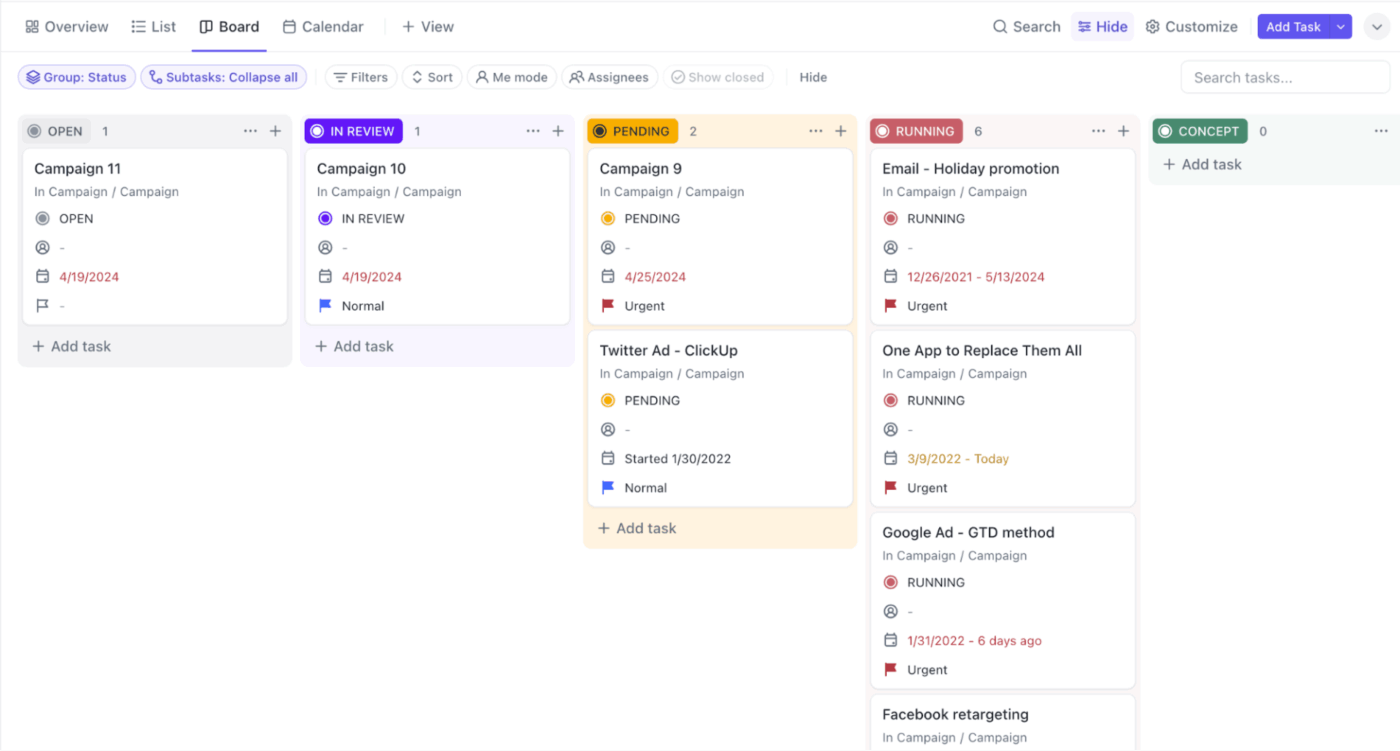
ClickUp Views supports this structure through formats that match how teams think about their work:
For example, a PMM preparing a reporting upgrade opens Board View and notices that the content is stuck because SME feedback hasn’t come in. The portfolio marketer checks Timeline View and instantly sees that this delay pushes the launch into the same week as a brand campaign.
They adjust dates in minutes instead of letting the conflict explode later.
🧠 Fun Fact: In July 1996, the free web-mail startup Hotmail launched with almost no traditional advertising budget. Instead, they added a simple line at the bottom of every email sent by their users: ‘Get your free e-mail at Hotmail.’ This turned each user into a walking referral source.
Campaigns land cleanly when the handoff from launch work to amplification work feels automatic.
Product teams finish their prep: messaging, assets, QA, and final checks. Portfolio teams focus on channels, timing, and narrative. Problems start when these two tracks fall out of sync, like messaging is ready but creative hasn’t started, or QA finishes, but no one alerts demand gen.
You want a setup where approvals, readiness checks, and content progress automatically push work forward.
ClickUp Automations help lock this rhythm in place. They run on simple ‘if this, then that’ triggers to remove all the manual follow-ups that usually stall launches. Once teams set these rules, the workflow stays consistent no matter who’s working on the project or how busy the week gets.
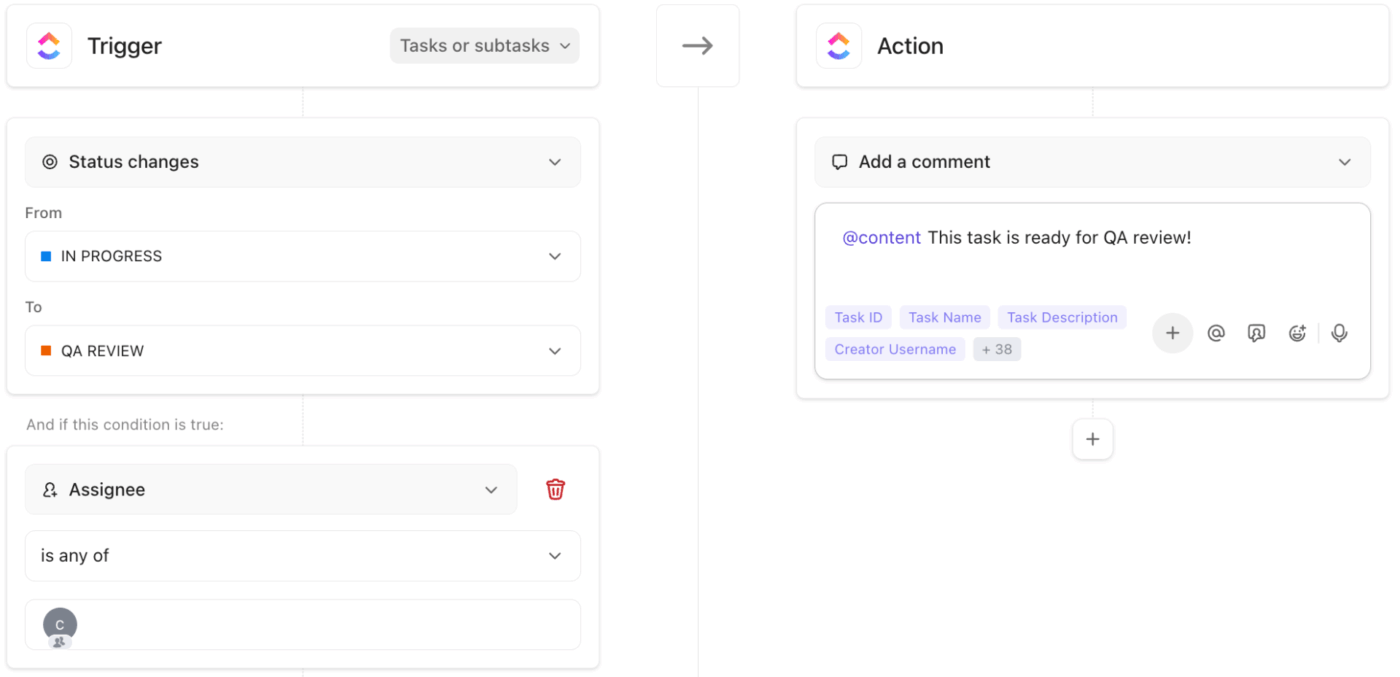
Here are some workflow automation examples:
Performance tracking helps teams understand how each product contributes to the bigger strategy, which launches drive meaningful change, and where energy should go next.
Portfolio marketers look across products to spot patterns. PMMs zoom into how their releases affect adoption, engagement, and ICP behavior. A clear view across products removes guesswork and keeps planning grounded in reality instead of assumptions.
Plus, when these signals sit together, it becomes easier to see which products gain traction, which ones flatten out, and which updates deserve more visibility in upcoming campaigns or messaging decisions.
ClickUp Dashboards keeps this context in one place so teams don’t piece findings together manually. These Dashboards are made up of Cards that pull in data from your ClickUp workspace. What’s more, you can filter by product line, persona, quarter, GTM asset, whatever you need to see the story.
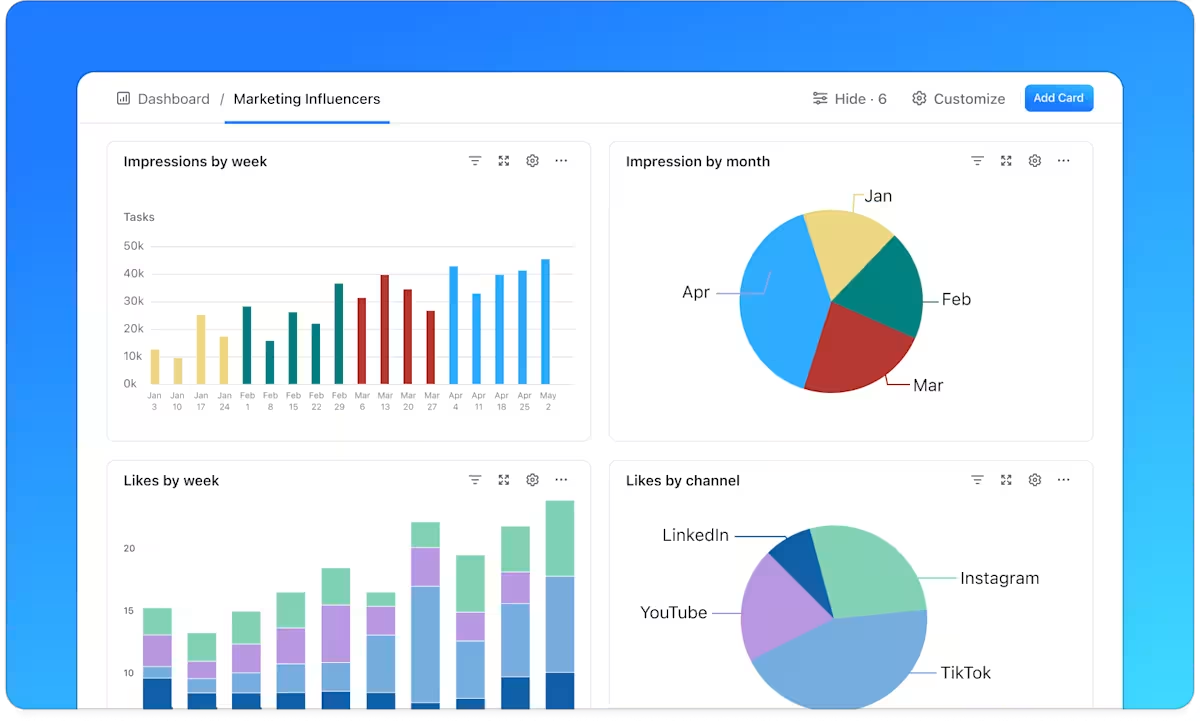
You can try these Cards for a complete overview:
🚀 Quick Hack: Teams often look at Dashboards and know something happened, but still need help understanding what it actually means. AI Cards in ClickUp solve that gap by turning your data into short, useful summaries you can read at a glance.

AI Cards work by pulling information from tasks, statuses, and fields in the connected spaces and generating a clear interpretation of what changed or why something stands out.
For example, the:
Marketing teams manage launches, campaigns, cross-functional approvals, creative production, and reporting all at once. When work spreads across disconnected tools, priorities blur and teams lose speed.
Here’s how ClickUp for Marketing Teams solves this. ✅
Tool sprawl hits teams when briefs, campaign plans, assets, approvals, and metrics live across random docs, tools, and chats. Marketing feels scattered, and no one gets a full view of what’s happening across product launches and portfolio-wide themes.
You plan campaigns, assign tasks, track progress, and review performance without switching tabs or hunting for context in ClickUp. Product marketers can map feature launches, while portfolio marketers align big-picture messaging and multi-product narratives in the same environment.
Chelsea Bennett shares her thoughts on using ClickUp at Lulu Press:
A project management platform is essential for a marketing team, and we love that it helps us stay connected to other departments. We use ClickUp literally every day, for everything. It has been very helpful for our creative team and has made their workflow better and more efficient.
A launch usually starts with five different versions of context: roadmap notes inside one task, competitor research in another, and positioning buried in a doc. Pulling all of that together takes longer than the actual planning.
ClickUp Brain steps in at this exact moment. It works inside your workspace, pulls context from connected apps + everything linked to your project, and turns that into a clean, structured brief you can act on.
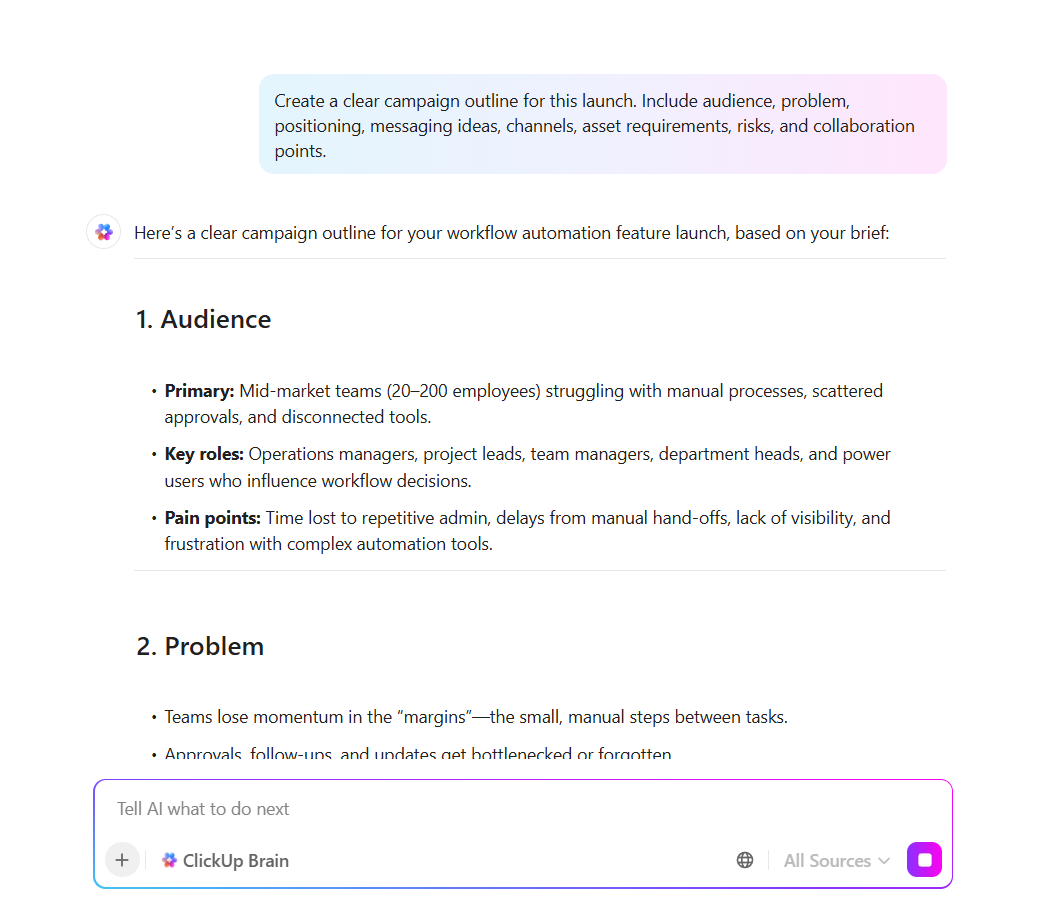
For example, a product marketer is preparing the campaign plan for a feature release. Before briefing design and content, they need a tight outline that captures the essentials.
They prompt ClickUp Brain, and within seconds, they get a clean structure with the audience breakdown, problem framing, positioning direction, messaging ideas, recommended channels, asset requirements, and cross-team collaboration points.
Portfolio marketers follow the same workflow for multi-product campaigns by asking ClickUp Brain for a starting point to remove context gathering from the equation.
📌 Try this prompt: Create a clear campaign outline for this launch. Include audience, problem, positioning, messaging ideas, channels, asset requirements, risks, and collaboration points.
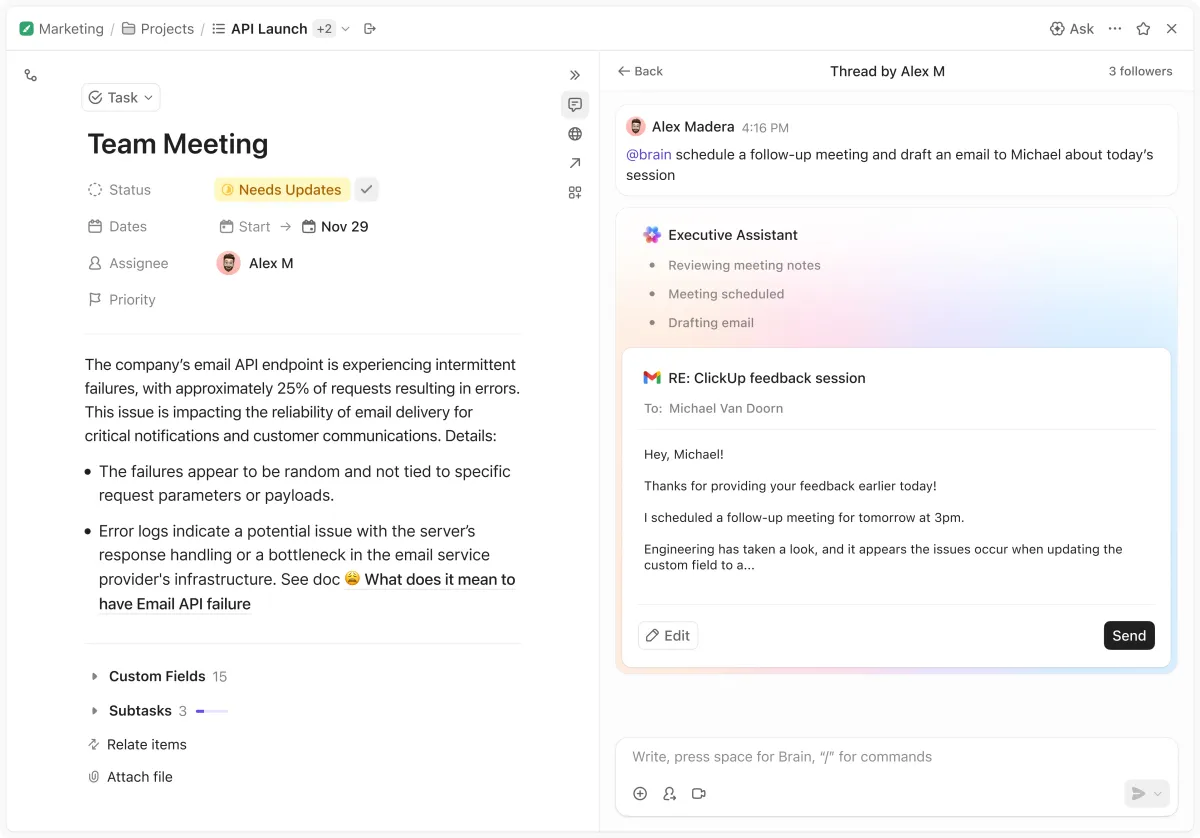
Curious about where to start with AI in marketing? This beginner-friendly guide lays out how to use AI for marketing by walking through tools, sample prompts, and real-world results you can replicate.
Building on ClickUp Brain’s capabilities, ClickUp Brain MAX is a voice-first productivity companion designed for marketers and product teams who don’t want to type every move.
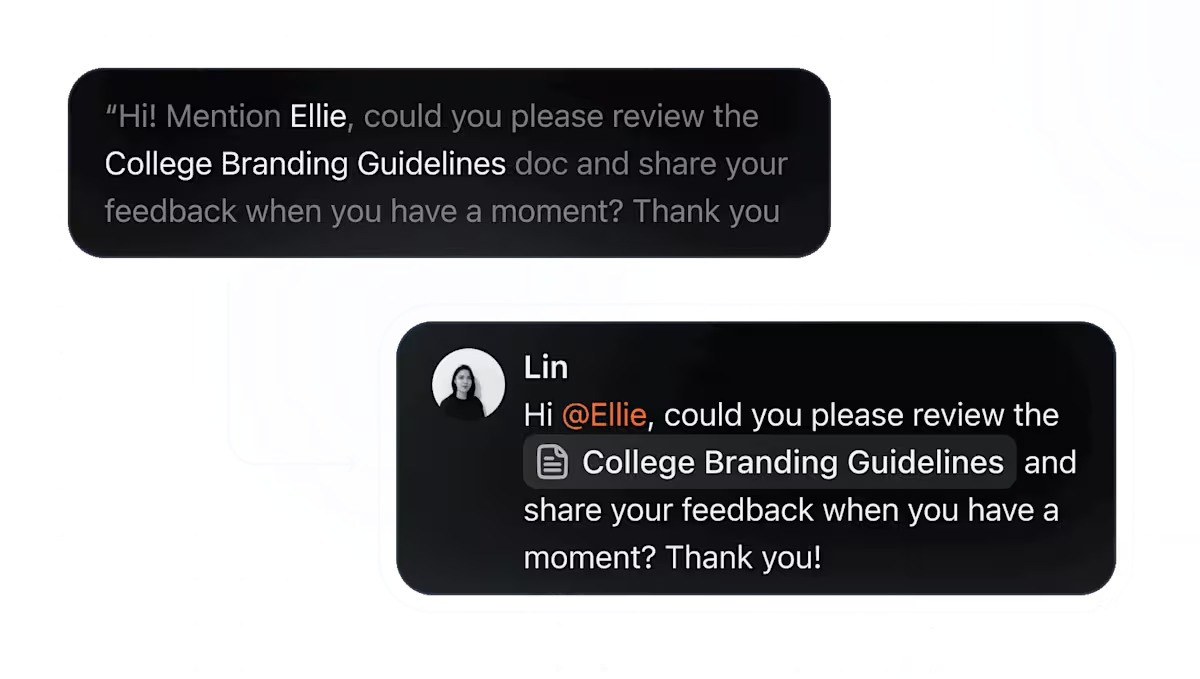
Talk to Text in ClickUp Brain MAX listens to your voice, understands your goals, and turns your ideas into action. It helps you skip the keyboard and move 4x faster.
Here’s how it supports portfolio and product marketing workflows:
Once you have planning and voice input in place, coordination and execution still need attention. ClickUp Agents help here.
These are custom or pre-built ‘bots’ inside your portfolio and product marketing tool that watch for triggers, take action, assign tasks, update statuses, and reduce manual hand-offs.
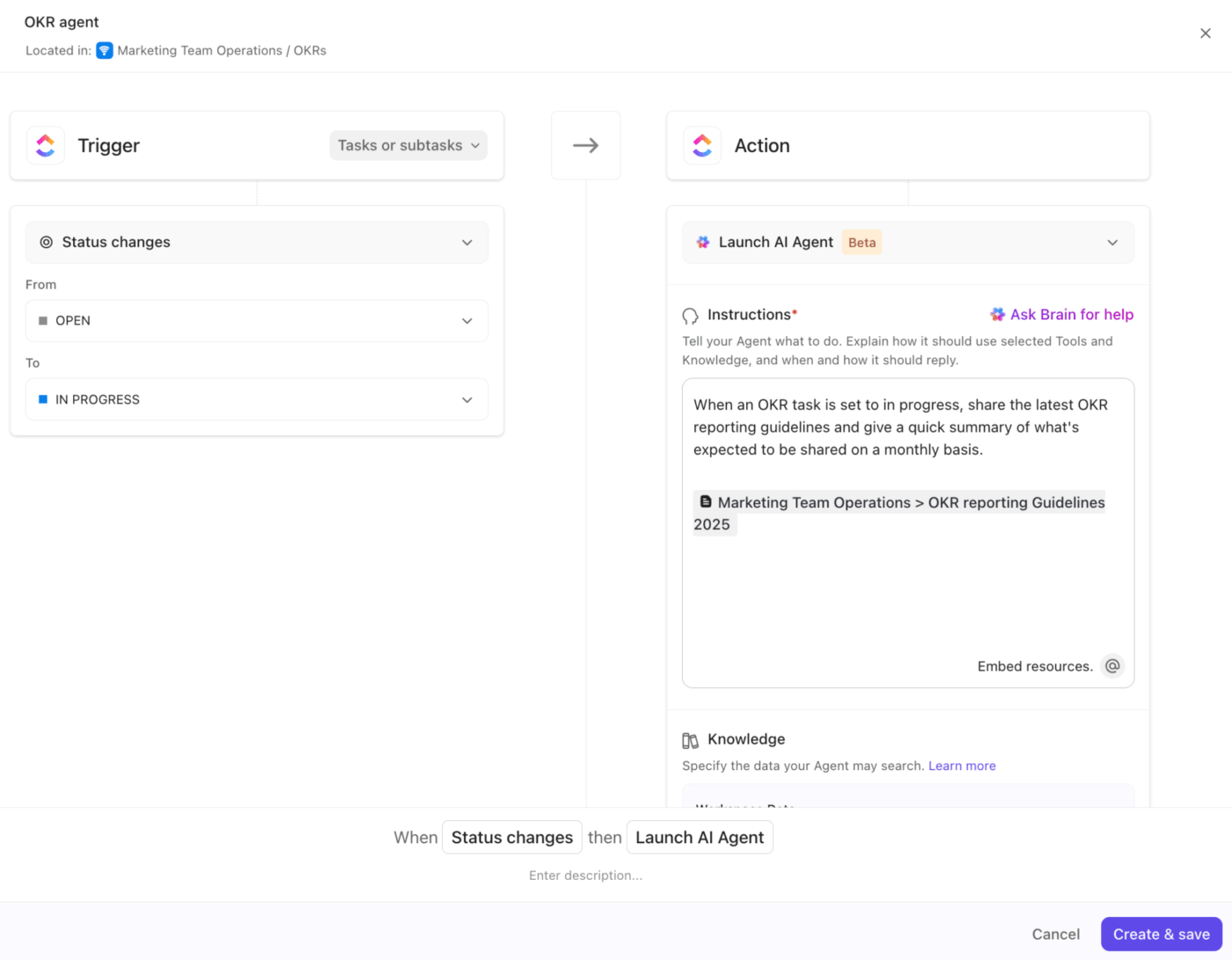
Here’s how that plays out in day-to-day marketing work:
🔍 Did You Know? As software markets grow more competitive and customers demand faster value, simply building a product is no longer enough. McKinsey found that high-growth software firms have about one product-marketing manager (PMM) for every 1.6 product managers (PMs), a ratio that is 25-30% higher than in slower-growing firms.
Portfolio marketing vs. product marketing always feels like two different gears, and both need attention at different points in your workflow. ClickUp helps you run both tracks without losing your rhythm.
Docs hold portfolio themes and product-level plans in one place, so strategy stays connected. Views help teams track releases, creative progress, and campaign timelines without losing the bigger picture. Dashboards highlight adoption trends and cross-product performance, making it easier to see what needs attention.
ClickUp Brain, Brain MAX, Automations, and Agents support faster planning, cleaner handoffs, and fewer blockers across both marketing tracks.
With everything working together, teams switch between suite-level thinking and product-level execution without breaking flow.
So, why wait? Sign up for ClickUp today! ✅
Portfolio marketing focuses on positioning the full solution set, shaping messaging across multiple products, and aligning everything to market segments. On the other hand, product marketing focuses on a single product’s narrative, launch plan, feature adoption, and competitive positioning.
Yes. Many teams manage both, as long as responsibilities are clear. Portfolio marketers guide segment strategy and high-level narratives, while product marketers focus on product-specific messaging and enablement. This structure keeps alignment tight without overwhelming teams.
Portfolio KPIs track segment traction, pipeline coverage, and overall solution awareness. Product KPIs measure feature adoption, activation rates, win-loss performance, and launch impact. One looks at market-level outcomes; the other evaluates product-level performance.
Teams often use ClickUp and HubSpot to help track launch plans, manage research, organize assets, and coordinate cross-functional timelines for both portfolio and product initiatives.
ClickUp supports planning, project tracking, content workflows, and cross-team visibility. Features like ClickUp Dashboards, ClickUp Task Priorities, ClickUp Custom Task Statuses, and ClickUp Docs help marketing teams coordinate launches, organize research, track performance, and maintain a central source of truth for strategy execution.
© 2025 ClickUp